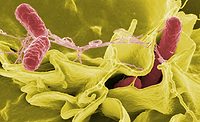IFSAC 2021 Foodborne Illness Source Attribution Report Shows Salmonellosis Caused by Variety of Foods

The Interagency Food Safety Analytics Collaboration (IFSAC)—a joint effort between the U.S. Food and Drug Administration (FDA), the U.S. Centers for Disease Control and Prevention (CDC), and the U.S. Department of Agriculture’s Food Safety and Inspection Service (USDA’s FSIS)—has published its 2021 report on foodborne illness source attribution for Salmonella, Escherichia coli O157, and Listeria monocytogenes.
According to the report, each year in the U.S., an estimated 9 million people fall ill, 56,000 people are hospitalized, and 1,300 people die of foodborne illnesses caused by known pathogens. To develop effective prevention measures for foodborne illness, the federal agencies comprising IFSAC conduct the annual source attribution report to better understand which types of foods contribute most to the problem. By bringing together data from CDC, FDA, and FSIS, and by developing sound analytical methods, IFSAC scientists aim to improve estimates of the sources of foodborne illness.
Using outbreak surveillance data from 1998–2021, the report presents annual estimates of the percentages of foodborne illness attributed to 17 food categories (chosen based on the regulatory agencies’ classification needs) for Salmonella, E. coli O157, and L. monocytogenes. Although Campylobacter is another priority pathogen for IFSAC, attribution estimates for Campylobacter are not presented in the 2021 report due to observed limitations of using outbreak data to attribute Campylobacter illnesses to food sources. IFSAC is exploring alternative approaches for estimating the sources of Campylobacter illnesses.
Salmonella, E. coli O157, L. monocytogenes, and Campylobacter are priority pathogens for IFSAC due to the frequency and severity of illness they cause, and because targeted interventions can significantly reduce such illnesses.
Based on data extracted from CDC’s Foodborne Disease Outbreak Surveillance System (FDOSS), IFSAC’s analysis included 1,322 outbreaks that occurred during 1998–2021, in which the confirmed or suspected implicated food or foods could be assigned to a single food category. Of these, 987 were caused or suspected to be caused by Salmonella, 275 by E. coli O157, and 60 by L. monocytogenes. Additionally, 46 outbreaks were caused by multiple serotypes of Salmonella. Due to down-weighting, the last five years of outbreaks provided the majority of information for the estimates.
In general, estimated Salmonella illnesses were more evenly distributed across food categories than illnesses from E. coli O157, and L. monocytogenes, as most of the illnesses for the latter two pathogens were attributed to one or two food categories. Over 75 percent of Salmonella illnesses were attributed to seven food categories: chicken, fruits, pork, seeded vegetables (such as tomatoes), other produce (such as nuts), beef, and turkey.
Regarding E. coli O157, more than 80 percent of illnesses were attributed to vegetable row crops (such as leafy greens) and beef. Vegetable row crops had a significantly higher estimated attribution percentage than all other categories, while beef had a significantly higher estimated attribution percentage than all categories other than vegetable row crops. No illnesses caused by this pathogen were attributed to eggs or oils-sugars.
Finally, over 75 percent of L. monocytogenes illnesses were attributed to dairy, vegetable row crops, and fruits. However, the credibility intervals for the dairy, fruits, and vegetable row crops categories were quite wide, partly due to the small total number of outbreaks (60). No cases of listeriosis were attributed to other meat/poultry, game, other seafood, grains-beans, oils-sugars, or seeded vegetables.
Looking for a reprint of this article?
From high-res PDFs to custom plaques, order your copy today!






